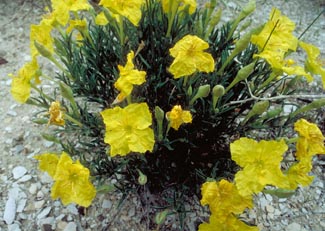Yellow Evening Primrose

Common Name(s):
Yellow Evening-primrose
Yellow Eveningprimrose
Long-tube Evening-primrose
Scientific Name:
Oenothera flava (A. Nels.) Garrett
Scientific Name Synonyms:
None Known
Symbol:
OEFL
Description:
Life Span: Perennial
Origin: Native
Growth Characteristics: A low-growing member of the Evening Primrose family, Yellow Evening-primrose bears quite a resemblance to the Dandelion, growing in dense tufts. It is sparsely covered with minute, straight, stiff hairs, or nearly glabrous.
Flowers: Yellow evening primrose flowers are about 1 ½ - 2 inches in diameter. The flowering stem is 4 inches tall, and does not exceed the length of the leaves. The flowers open in the evening and are solitary at the tips of flower stalks. The calyx is actually purplish, with slightly fused lobes. The petals are yellow, aging to purplish, and are ½ to ¾ inch long.
Fruits/Seeds: Capsules which are conspicuously 4-winged, ½ to ¾ inches long.
Leaves: Yellow evening primrose leaves are deeply incised and quite long – up to 10 inches in length. The long lance-shaped leaves are in tufts or rosettes, 2-8 inches long, up to ½ inch wide. The lower part of the leaf is deeply cleft or lobed half the distance or more to the middle. The uppermost part is entire to somewhat wavy and toothed.
Stems: Up to 4 inches tall, sparsely covered with minute, straight, stiff hairs, or nearly hairless.
Roots: Rhizomatous
Ecological Adaptions:
Yellow evening primrose is found in moist areas throughout Utah.
Soils: Moist, well-drained, rocky soils.
Associated Species: Redtop, sedges, willows, rushes
Uses and Management:
Cattle seem to avoid evening-primrose. Young shoots and roots of some evening-primroses are eaten by humans.

